Hubble telescope catches stunning view of Comet NEOWISE after its spectacular summer sky show

The Hubble Space Telescope turned its powerful eyes to a celestial visitor to our skies — Comet NEOWISE, which put on a stunning show in the Northern Hemisphere earlier this summer.
On Aug. 8, the famed telescope obtained images of the comet's coma, which is the cloud of gas and dust bleeding off the icy comet as the sun's energy strikes the surface. At 27 million miles (43 million kilometers) from the camera, Comet NEOWISE was a triple milestone for Hubble's imaging capabilities.
"This the first time Hubble has photographed a comet of this brightness at such resolution after this close of a pass by the sun," NASA said in a statement, adding that the nucleus managed to stay together even after the swing past our nearest star.
Related: Amazing photos of Comet NEOWISE from the Earth and space
"Hubble has far better resolution than we can get with any other telescope of this comet," Qicheng Zhang, a graduate student at the California Institute of Technology who led the imaging campaign, said in the same statement. "That resolution is very key for seeing details very close to the nucleus. It lets us see changes in the dust right after it's stripped from that nucleus due to solar heat, sampling dust as close to the original properties of the comet as possible."
While Hubble has powerful eyes gazing out from its perch in Earth orbit, the telescope does not have enough resolution to spot the nucleus directly; the team estimates the nucleus is only 3 miles (about 5 km) across. But the image does show the gigantic cloud of gas and dust stretching around the nucleus, spanning roughly 11,000 miles (18,000 km).
Hubble also saw two jets spewing out from the nucleus in opposite directions, which fanned into curves as the heart of the comet rotated. Just like the coma, the jets are formed by the sun's energy striking the comet's surface. In this case, however, the jets shoot out at higher velocity as the ice changes directly from solid to gas beneath NEOWISE's surface.
Breaking space news, the latest updates on rocket launches, skywatching events and more!
The images of NEOWISE could help researchers learn more about dust in the early solar system. Since comets are considered icy leftovers of the solar system's youth, studying these small bodies reveals much about how our current neighborhood came to be.
Researchers hope to pinpoint the color of NEOWISE's cometary dust and analyze how the colors change as the comet continues to fly away from the sun and the inner solar system. These properties are expected to show how the heat of the sun changes the composition and structure of dust in the comet's coma.
As for NEOWISE, it continues to fade from our view as it rockets back toward the outer solar system, with an expected return to the sun in about 7,000 years. It was the brightest Northern Hemisphere comet since Hale-Bopp, which appeared in 1997.
Follow Elizabeth Howell on Twitter @howellspace. Follow us on Twitter @Spacedotcom and on Facebook.
Join our Space Forums to keep talking space on the latest missions, night sky and more! And if you have a news tip, correction or comment, let us know at: community@space.com.

Elizabeth Howell (she/her), Ph.D., was a staff writer in the spaceflight channel between 2022 and 2024 specializing in Canadian space news. She was contributing writer for Space.com for 10 years from 2012 to 2024. Elizabeth's reporting includes multiple exclusives with the White House, leading world coverage about a lost-and-found space tomato on the International Space Station, witnessing five human spaceflight launches on two continents, flying parabolic, working inside a spacesuit, and participating in a simulated Mars mission. Her latest book, "Why Am I Taller?" (ECW Press, 2022) is co-written with astronaut Dave Williams.
